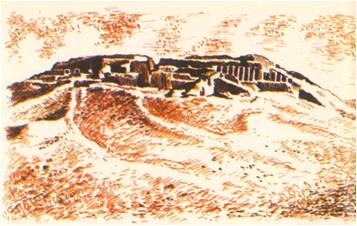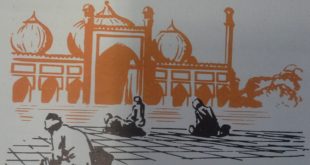It was around 3500 B.C. and as it did every year around the middle of July, the Nile had begun to rise. Carrying tons of soil, the waters poured down from the mountains of Africa, where the rain and melting snow fed the streams that surfed northward into one great river. Wherever it ran free of the rocky canyons, the river overflowed onto the dry fields along its banks. It lapped against the villages on high ground and spread to market towns on the edges of the dessert. Moving northward, the river engulfed the entire Delta region and then emptied into the Mediterranean Sea. By mid-November the waters receded, leaving a thick, dark mud on the fields and in the canals.
Near one of the largest towns far up the Nile, the farmers stood waiting at the edge of the fields. Then from the town came the king, followed by guards, priests and servants carrying large fans. The king wore a high white crown and carried a hoe. Scooping some fresh mud out of an irrigation ditch, he placed it in a basket held by an attendant. While the priests chanted, the mud was spread over the field. Now the farmers could plant in the fertile earth left by the floodwaters. The king, who was responsible for the well-being of his people, had performed a great duty.
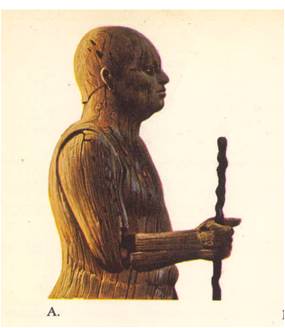
As his white crown indicated, this king ruled only in Upper Egypt. In the Delta to the North there was another king, who wore a red crown. For many years the people of Lower and Upper Delta had been fighting and raiding each other’s towns. However, they all had common ancestors who had come from Africa to the south, from Libya to the west and from Asia to the north and east. Through thousands of years these people had mingled in the Nile valley, until finally they had become one people, the Egyptians.
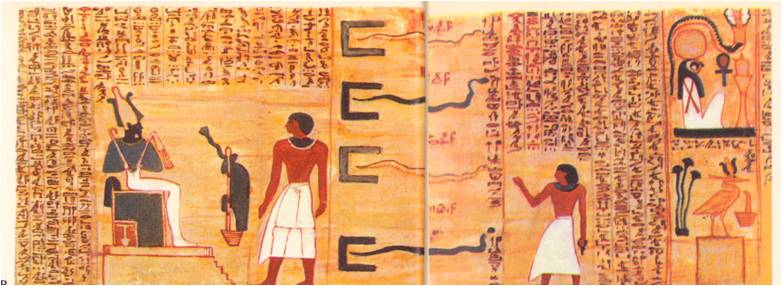
For almost 3000 years, Egypt remained two lands. Upper Egypt was a little more than a narrow valley that stretched north from this rocky First Cataract of the Nile. This Egypt came out of the African world, with its tribal life and priest-kings who brought rain to their people. Upper Egypt always kept in touch with their African neighbours. At the same time, the people of Upper Egypt had been forced to cooperate to survive on their narrow farmlands. As a result, they developed politically sooner than in Lower Egypt.
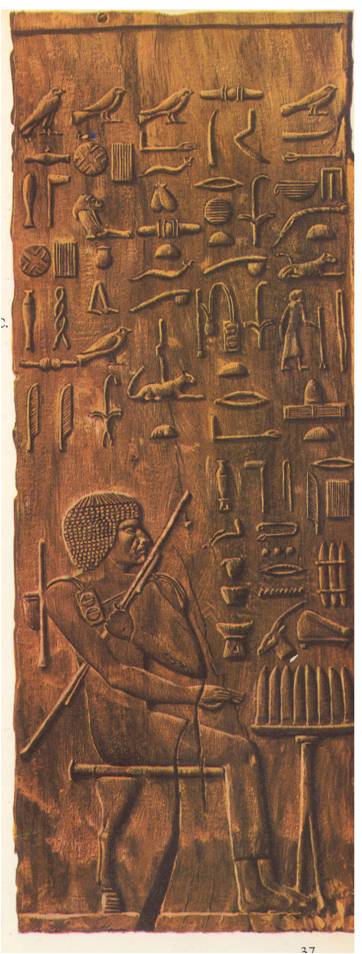
Lower Egypt was the broad Delta where the Nile split into many rivulets. Here were some fertile lands, marshes of reed and papyrus, lush pastures and a rich stock of wildlife. The towns were more spread out and there was less need for the people to cooperate. Moreover, Lower Egypt had some contact with the outside world – the eastern Mediterranean, Libya to the west and lands to the north and east where many Semitic people lived. Thus the people of Lower Egypt became more advanced culturally than their relatives to the south.
Upper and Lower Egypt were divided in still other ways. They spoke many different dialects and worshipped many different gods. It might seem then, that they could never be united, but they had a bond that proved to be stronger than all the forces that pulled them apart. The bond was the Nile River – the god “who comes to nourish Egypt”. It gave Egypt a unity that most lands of the time would never know.
In Mesopotamia for instance, the city-states shared a common background but they were spread out with no clear centre and there was continual rivalry among them. Furthermore, Mesopotamia was surrounded by many other lands and was always in contact with foreign peoples and forces. Egypt, confined to the Nile valley, drew strength from its isolation. From the beginning too, the Egyptians looked to a central authority in the person of the king worshiped as a god. Despite all their differences, the people, the regions, the kings and the gods, were all held together by the Nile.
A UNITED EGYPT
For some time before they actually united, however, the kings of the north and south fought to control more of each other’s villages and farmlands along the Nile. Then about 3200 B.C., King Narmer of Upper Egypt made a bold move. Capturing only the main towns and large estates along the way, he went up into the Delta and took the capital of Lower Egypt. The few nobles and chieftains who resisted were beheaded. King Narmer could now wear the red crow of Lower Egypt as well as the white crown of Upper Egypt. As king of the Two Lands he started a capital at Memphis and set about to bring some unity to the villages strung along the Nile.
King Narmer could do little in his lifetime, but during the next few centuries other kings made a true nation out of the Two Lands. There were still many gods – for every city and craft, for everything that men did and everything in nature – but certain gods such as Horus came to be recognized by everyone. The country was divided into districts, each governed by a man appointed by the king. They saw to it that taxes were collected and that the fields were drained and irrigated. For the purpose of keeping records, a special calendar with a 365-day year was adopted, as were standard measures for surveying fields and dividing produce.
HIEROGLYPHS AND PAPYRUS
Although the Egyptians were somewhat isolated from the rest of the world, they could hardly help but be influenced by their neighbours in Mesopotamia but the Egyptians branded their own style to concepts they adopted. For example, the Mesopotamians had developed writing, in which each sign stood for a syllable (having one vowel sound). The Egyptians borrowed the idea but made their own set of signs from familiar objects, most of which also stood for sounds. Thus, when they wanted to write King Narmer’s name, they placed a small fish called a “nar” over a chisel, pronounced “mer”. This gave them “Narmer”.
Using these picture-signs, or hieroglyphs, the Egyptians began to carve and paint inscriptions on their monuments. The scribes who wrote the letters and kept records developed a quicker way of writing. They used a reed pen and ink to write on sheets of papyrus, made of the pressed fibres of the papyrus plant. With such materials the scribes found it easy to simplify and round off the picture signs. It took much training and the scribes became a highly respected class.
“A CITY FOR THE DEAD”
Egypt was now a growing nation. It took control of the territory far up the Nile, it carried on trade with the Phoenicians along the Mediterranean coast and began to work the rich copper mines of the Sinai Peninsular. Up and down the Nile sailed many ships, taking government officials to their posts and picking up produce for taxes. On the great estates along the river stood fine houses whose owners had musicians and dancers to entertain them. In the marshes and thickets, men hunted wild birds and game. In the fields and villages, people were growing and reaping the crops, tending the animals and celebrating their festivals.
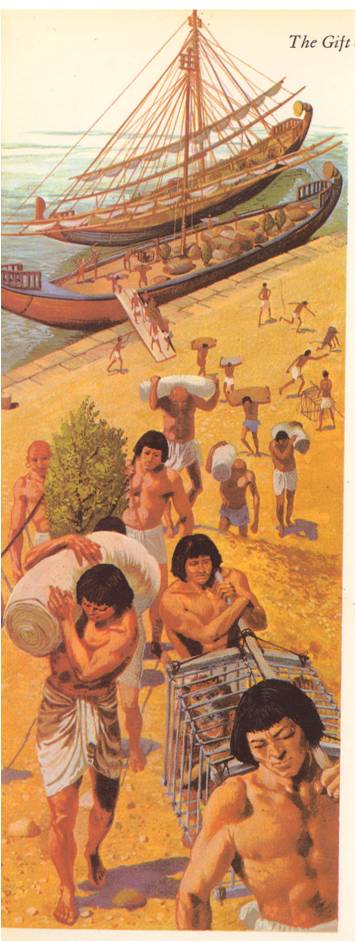
Most of the people worked on their own small farms or on the great estates and seldom went far from their village. Sometimes however, the men went off to serve with the army or to work on some royal building project. If a man showed great skill as a craftsman or sailor, he could hope to be hired by the king. Men with ambition could also become scribes or priests or government officials. The government had become a complicated organization, with all its officials and activities supervised by the vizier, the man “to whom is reported all that is and is not”. Each day the vizier, in turn, reported on the state of affairs to the king and received new orders.
Over all Egyptians, like the top stone of a pyramid, was the king. He assured harmony to the nation, fertility to the land and the blessings of the gods to his people. They felt that when the king prospered, Egypt prospered; in working for him they were working for their own well-being. The king was worshipped as a god. Sculptors depicted him towering over all other men or sitting in eternal majesty. Later the king was called the Pharaoh, the “great house” who sheltered all his people. The high nobles and officials wanted to be buried near him, for the king would have eternal life and they wanted to share it.
For some time the kings had been building larger and larger tombs. They were mudbrick structures, with sloping sides and flat tops. Then about 2700 B. C. King Djoser decided that he would have a special tomb. He consulted his vizier, Imhotep, a brilliant man who was a doctor and writer as well as an engineer. Together they planned a tomb that would dwarf the ones that had been built at Saqqara, outside Memphis.
Imhotep supervised the construction of a series of terraces rising to form a step-like pyramid. It was made of stone; in fact, it was the largest stone structure of its day. Within the pyramid was the burial chamber for King Djoser and around it were temples and a great wall. It was truly a city for the dead and everyone who saw it was convinced that the Pharaoh was a god.
THE GREAT PYRAMIDS
A century later, King Khufu decided that he must have a tomb to surpass all others. He chose a site at Giza and with his vizier Hemon, he planned a structure that could be enlarged as his reign went on. It was an enormous job of organization to supply the men and materials that were needed. Hundreds of stone cutters were put to work in quarries to cut the great rough blocks of limestone. At Giza, a village grew to house the thousands of men who worked there and arrangements were made to feed them. The heavy blocks of stone, some weighing as much as 15 tons, were hauled in during the flood season, when thousands of extra workers were employed.
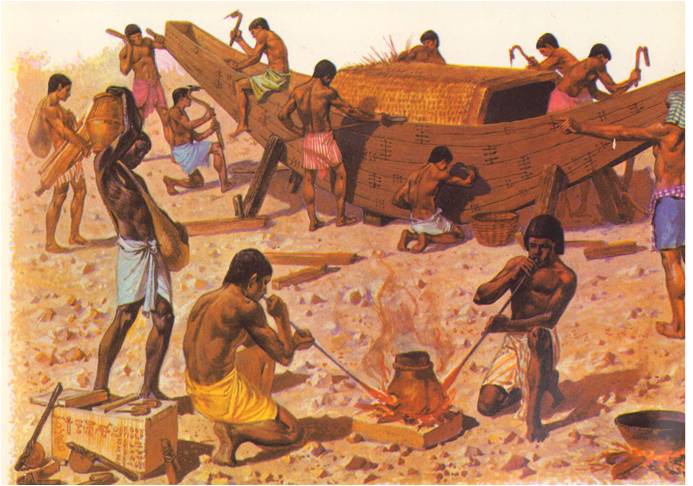
After enough blocks had reached Giza for work to begin, the base of the pyramid was laid. Then starting at each corner, ramps of rubble and mud were built. The second layer of blocks was dragged up the ramps and placed in position on the base. As the pyramid rose, layer by layer, the ramps rose alongside. Several thousand men dragged the blocks on sledges up three of the ramps; other men dragged the empty sledges down the fourth ramp.
The rough limestone for the centre of the pyramid was quarried nearby, but the finer stone for the outer casing came from across the river and had to be floated over the barges. The final trimming and polishing of the stones was done at the pyramid by skilled masons, who worked with great precision. Blocks weighing two and a half tons were cut so that their edges and corners fit almost perfectly. Engineers checked to make sure that each layer was flat and square. When the final stone was in place, the men worked down from the top, smoothing the outer blocks and removing the ramps.
Finally, after about 20 years of work, the great gleaming pyramid rose from the desert. Built of more than 2 million blocks of limestone, it stood some 480 feet high. Around the pyramid were other structures, such as the great wall, a covered passage to the temple at the river’s edge and the smaller tombs of those that were privileged to join the king in the afterlife. Later, the great pyramids of Khafre and Menkaure, the kings who followed Khufu, were built nearby.
Within the pyramids and the tombs lay the kings, nobles and high officials in their coffins, their bodies preserved with rare oils and fluids and wrapped in linen. In the burial chambers were the foods, clothing, jewellery, weapons and everything else they needed in the afterlife.
The pyramids were a ceremonial centre from which all Egyptians could draw strength and pride but the land could not afford many such memorials to the dead kings. Menkaure’s pyramid was in fact, quite a bit smaller to Khufu’s and Khafre’s tombs. It was not only that people resented the expense, but also that other groups were now challenging the power of the kings. The priests at Heliopolis, “the city of the sun” where the sungod Re was worshipped, were growing much stronger. At the same time, district governors and local nobles were beginning to rule their territories more independently.
The New Kings
By 2200 B. C., Egypt had entered a period of upheaval. Law and order broke down. The tombs were robbed, the stone was stripped from the buildings and the priests no longer performed the proper ceremonies. Local nobles took up the burial customs of royalty. “Why, really”, wrote one man, “the land spins around as does the potter’s wheel. The robber is now the possessor of riches.” Another man complained, “I show thee the land topsy-turvy. That which never happened has happened”.
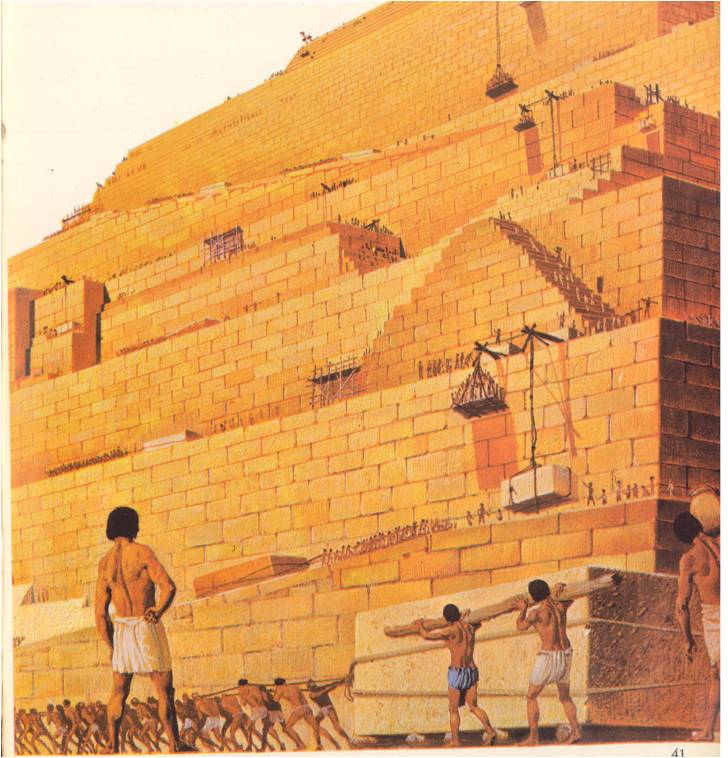
Inspite of the disorder, it looked as though a new kind of society might develop, one in which more people would share the power. Instead, the old order was restored by force. By 2050 B.C., a family at Thebes, a city on Upper Egypt, had gained command over much of Egypt. They were followed by another family from Thebes, the twelfth great dynasty to rule over the Two Land. The new kings wisely moved their capital from Thebes to a city nearer the border of Upper and Lower Egypt. They did not try to take away the powers of the lower officials and governors, but only asked for their loyalty. In this way the twelfth dynasty was able to rule for two centuries.
Once again Egypt was prospering. The old boundaries were restored, careful records of the Nile’s flood levels were kept and there was much building. At Harawa a temple was built with so many courtyards and colonnades that it became known as a labyrinth, or maze. Egypt’s trading ships once more went far up the Nile. They sailed to Crete, to the posts of Phoenicia and even to the land of punt on the African coast. Egypt sent out its gold, metalwork and papyrus and received in return the wine, oils and wood of its neighbours.

Since the new kings were from Thebes, they naturally encouraged the worship of the Theban gods. The most important of them was Amon, the invisible god of the air. The Egyptians were used to accepting new gods and soon combined him with the sun-god Re. Amon-Re became the national god of Egypt. The king himself was once again looked upon as a god and gradually he regained most of his power. Still, the king was no longer the superhuman figure who sat rigid and isolated, as in the days of the old kingdom.
Once again the Egyptians were self-confident and cheerful, as they had been in the early days. For, despite the great tombs and the funeral ceremonies, the Egyptians were lovers of life. It was because of their love of life that they were so much concerned with what happened after death. They hated to give up the good things of life and wanted to go on enjoying them in the after-world.
The mass of poor and illiterate Egyptians were barely affected by the prosperity of the years under the twelfth dynasty. They could only accept their position in society and hope that peace and order were maintained. For the rich and educated, however, life was good. Perhaps this was best expressed by an Egyptian court official named Sinuhe. Even though he had to flee from Egypt because he once offended the ruling powers, he never lost his love for his homeland. Later, when he wrote the story of his life, he expressed his appreciation for having been allowed to return.
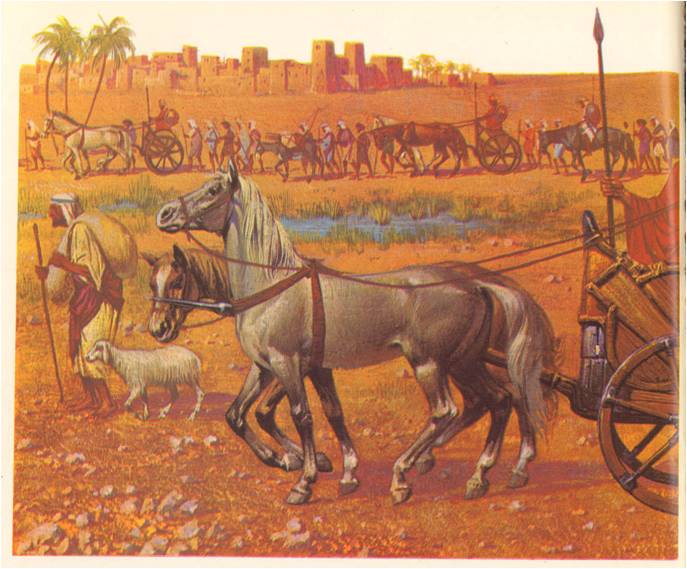
Sinuhe’s autobiography was only one of many works that had made this golden age of Egyptian literature. Letters, tales, proverbs, religious works – all showed great skill in expression. People wrote with charm and humour and enjoyed playing with words. The language and manner of writing survived for centuries as the classic Egyptian style.
The good life of the twelfth dynasty could not last. By 1800 B.C., Egypt began to lose some of its influence in Palestine and Syria. In western Asia, people were on the move and some of the unsettled and migrant peoples began to enter Egypt’s Delta. The Egyptians called them the Hyksos, “the rulers of foreign lands”. They were a mixed group from western Asia, although most were Semitic tribesmen. Some were harmless shepherds and drifters, but others were armed raiders. A stronger Egypt would soon have dealt with the Hyksos. Instead, by 1730 B. C., the Hyksos were taking power into their own hands.
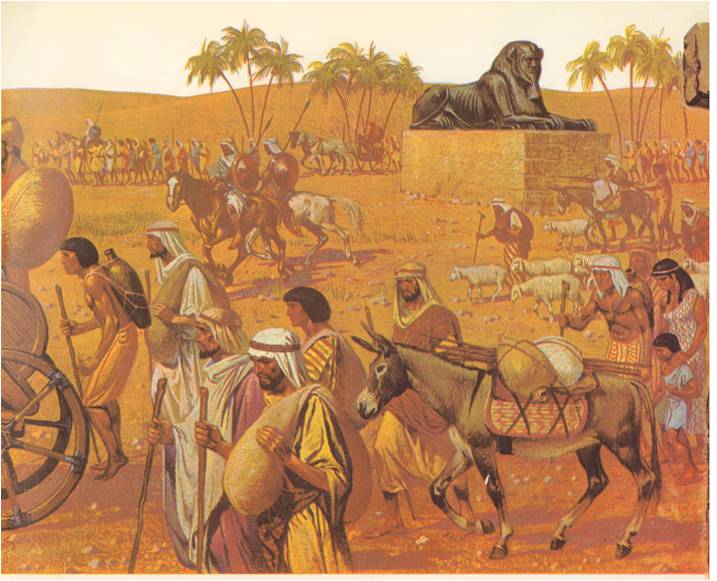
From their capital in the Delta, the Hyksos moved out and set up several other armed strongholds. Hoping to be accepted by the people, they took Egyptian names, adopted the royal titles and ceremonies and tried to appear as the official successors of the great kings. They neglected the Egyptian gods and temples; however, they were never really accepted by the people. In the end, the Hyksos were satisfied with tribute from native Egyptians.
Under the rule of the Hyksos, the Egyptians stopped working at the building and the literature that had been their pride. Such things meant nothing to the Hyksos warriors, whose contributions to Egypt were good body armour and weapons such as bronze swords and a strong kind of bow. Most important, the Hyksos introduced the Egyptians to the horse and chariot.
The Hyksos are Defeated
Around 1600 B.C., Kamose of Thebes decided he could steal no more and organized a revolt. It took great courage, for many of his own countrymen were satisfied to keep things as they were. Kamose led a fleet down the Nile, wiped out some of the Hyksos strongholds and captured a great deal of booty. His brother Ahmose completed the liberation and chased the Hyksos all the way into Palestine.
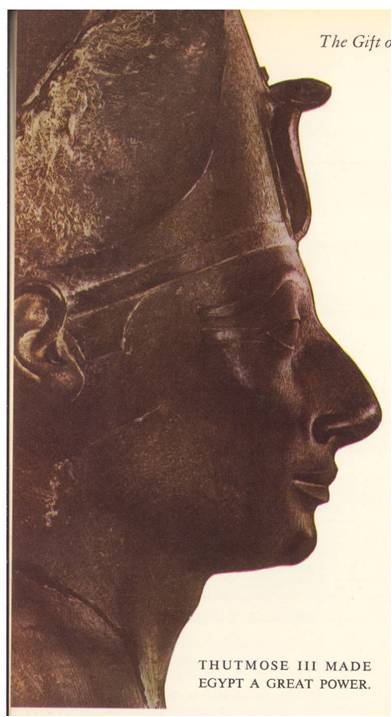
The despised Hyksos were gone at last and the Egyptians were free to take up their own ways. They hurried to show their gratitude to the gods by building new temples and reviving the old ceremonies. Now that Thebans were ruling again, the Theban god Amon was once more worshipped by the whole nation. The priests who officiated over the cult of Amon began to gain such wealth and power that they would rival the kings and other officials.
The Hyksos had left a permanent mark on the Egyptians. They had been conquered by foreigners – barbarians who did not even worship the proper gods. While recovering from this great shock, the Egyptians began to show a more ambitious spirit. At first the Theban kings were occupied in putting down revolts among various local nobles; then they began to extend their rule up the Nile into Africa. No longer satisfied with trading, Egypt also began to look abroad for possible conquests.
The Warrior King
Under Amenhotep I, Thutmose I and Thutmose II, Egypt became a military power, using the horse and chariot, paid soldiers and the new weapons and battle tactics. The Pharaohs themselves now led the army into the field, only one of the signs that the times were changing. From 1520 – 1480 B. C., Egypt was even ruled by a queen, Hatshepsut. She was a forceful personality who built new temples, advanced trade and brought peace and glory to her people. It was quite different from the old days, when the god-king was far removed from the people and the queen sat silently at his side.

Following her death, Hatshepsut was succeeded by her husband, Thutmose III. Thutmose III was determined to make Egypt into an imperial power. He was especially anxious to control Palestine and Syria for they were at the crossroads of many trading routes. His chief opponent there was the prince of Kadesh, a city-state on the Orontes River in Syria. The prince organised all their princes and chieftains of the region and they brought their troops to Megiddo, a city in Palestine that commanded the route to the north. Thutmose III brought his Egyptian army up and there on the plain of Megiddo they fought a furious battle.
The Egyptians won the battle, but they captured the city only after a siege of many months. Rather than slaughter his enemies, Thutmose III simply demanded that they take an oath of loyalty. Even so, Thutmose III had to fight continuously to hold his empire in western Asia. Throughout all his campaigns, Egypt grew richer. Her ships, caravans, messengers and armed patrols went everywhere, from Turkey in the north to Nubia in the south. Egypt was truly an international force.
Egypt’s empire brought wealth and power, but it also brought responsibilities and still greater changes. Egypt now had to support a large professional army and vast numbers of government officials. Through their contacts wit many different foreign peoples, the Egyptians’ traditional attitudes were changing. Under the earlier dynasties, art, society, religion and government had been rigid but they also gave the people a sense of security. Now it seemed that nothing could be depended on for long.
The Sun Worshipper
About 1370 B. C., Amenhotep IV came to the throne. He had none of the vigorous, out-going manners of the recent Pharaohs. He was not a good athlete and he was no soldier. He was a withdrawn, studious man, with a thin face and sloping shoulders. Even as a boy he had been interested in religion and as he grew older he became dissatisfied with all the established gods and their priests. Finally Amenhotep IV rejected Amon, re and all the other gods and began to worship Aton, the life giving sun. Aton was to be the universal god, Amenhotep decided and there were to be no idols of Aton. He would be shown only as the disk of the sun, with the rays coming down and ending in hands that gave life to all things.

Amenhotep changed his own name to Akhnaton, meaning “to the well-being of Aton.” He also decided to move the capital away from Thebes, with its powerful and jealous priesthood of Amon. He wanted to start a completely different way of life and he chose a new site at Amarna. There he began to build a great religious centre, with palaces and temples open to the sun instead of closed and dark like the sanctuaries of the other gods. Aton gave and demanded truth and everything has to be exposed to view.
Life at Amarna was different in many ways. Akhnaton and his beautiful wife Nefertiti moved about in public. Their people could see them playing with their six lovely daughters and when one of the girls died, Akhnaton was not ashamed to show his grief.
Akhnaton encouraged artists to work in the new spirit of truth and openness. Artists in the old kingdom had not tried to show realistic movement or expressions. Servants, children and workers might be depicted with realistic detail, but the Pharaohs and other important people were shown as ideal beings. Classic Egyptian art tried to freeze action and emotion into something universal and eternal. Under Akhnaton, art became more natural. Akhnaton himself was not depicted as some distant god, but as a relaxed human being. Writers, too, gave a truer picture of the life around them. They began to drop the classic literary language and use the language of the day.
In time, Akhnaton became almost a fanatic about his new faith. He was determined to do away with other gods, especially Amon, the god from Thebes. Akhnaton sent agents around the land to cut the name “Amon” out of stone inscriptions. He also demanded that his people worship himself as the son of Aton. The Egyptians were accustomed to worshipping their Pharaoh as a god, but they could not understand why Akhnaton rejected their many other gods.
Akhnaton was never able to attract many true believers outside the royal circle. Worse still, he had made many enemies throughout Egypt by turning his back on the empire his ancestors had built up. As the Egyptians lost influence in Africa and western Asia, they lost the source of their wealth. In the final years of his reign, Akhnaton became sickly and weak. When he died, his religion died with him and the Egyptians happily returned to all their old familiar gods.
The Tomb of Tutankhamon
Akhnaton’s successor, Tutankhamon, was only nine years old and the priests and high officials held the real power. Now that they were free to worship the god Amon again, they changed the young king’s name to Tutankhamon. When he suddenly died at the age of eighteen, the priests and officials were to give him the full royal burial. He was placed in three caskets, one within the other and all richly decorated. These were placed in a great stone sarcophagus within the burial chamber and all around were the objects for the afterlife. Amid all the shining gold were two small amulets and a dagger that were probably the most important treasures in the tomb, although no one realized it at the time. They were made of iron and it was iron that would one day help to bring an end to golden Egypt.

The old gods and the conservative forces were back on power, but they could not revive the classic Egyptian spirit. Narrow laws now replaced broad traditions, magic replaced faith. Then, about 1290 B. C., Ramesses II became king and it seemed as if he would bring back the old glory. Once again, Egypt was fighting and building. Yet behind much of what Ramesses II did was his desire to show off. Although he was unable to defeat the Hittites decisively, he boasted of his great victory at Kadesh, in Syria and had the story carved on several monuments. The monuments he built, such as the temples cut into the cliff at Abu Simbel, were often monstrously large.
Ramesses II had more than 100 children and ruled for more than sixty years, yet he left no foundation for Egypt’s future. Throughout Asia and the Mediterranean, whole peoples were on the move and among them were the Philistines. The Egyptians were able to keep the Philistines out of Egypt but they themselves lost influence in Palestine and the Phoenician ports.
The End of the Pharaohs
The great days of Egypt were over. One reason was that iron was coming into use among the peoples of western Asia and the Mediterranean. Egypt had no deposits of iron ore. To keep up with other countries and make the new and stronger weapons and tools, it had to import iron. This put an extra strain on its economy. Prices rose, wages fell and the great tombs were continually robbed for their treasures. By 1100 B. C., Egypt was a divided land. A Pharaoh still sat on the throne, but merchants, priests and the army held the real power.

It was a difficult time and many Egyptians tried to find comfort in the cult of the dead presided over by the god Osiris. Various groups of foreigners had been coming into Egypt for some time and now they became more and more powerful. By 950 B. C., a Libyan had established a new dynasty of kings. About 720 B. C., an Ethiopian made the first successful invasion of Egypt in a thousand years and took over the throne.
Then by 525 B. C., Persia easily conquered Egypt and turned it into a province of its empire. Later, Alexander the Great claimed Egypt for his own and still later the Roman emperors did the same. The great Pharaohs, the power, the wealth and the glory were all gone. All that the Egyptians could rely on was the Nile, the mighty river that rose and fell each year as always, bringing fertile soil to their farmlands.

